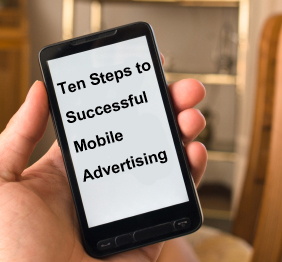In general, mobile advertising is generating higher clickthrough rates and greater returns on investment than any other form of advertising. But in order to achieve this level of success, you have to make sure you’re doing it correctly. Getting it right isn’t too difficult as long as you are prepared to do some quick learning and think about these ten simple steps:
1. Don’t forget the rules
All the tried and tested rules of marketing still apply to mobile. You can apply all the same goals and expectations that you would for a print or broadcast advertising campaign, as well as the same parameters for defining what you need to achieve. Identifying your target audience, targeting them in the right environment at the right time and planning the process from start to finish are all basic building blocks that you still need to apply in order to capture interest and attention.
2. The role of mobile
What exactly do you need mobile to do for your business? Mobile is a wonderful channel because it offers the opportunity to engage one-to-one with your customer and it offers many connectivity possibilities. But if you’re not targeted in what you want it to do, it won’t achieve anything. By defining the role of mobile and what you need it to do for your business, whether it’s extending your online sales channels or providing location-based CRM, your strategy will start to take shape.
3. Set your objectives
Before you start, it’s crucial to define your objectives for the mobile activity and decide what you want the campaign to achieve. It’s important to have realistic expectations about this and it’s a good idea, initially, to establish some benchmarks on what can be delivered. Don’t expect to be able to do everything in one go. If you haven’t done this before, this will be a learning process. Have one objective and be realistic about it and use the SMART criteria (Specific – Measurable – Attainable – Relevant – Timely) to help guide you. The next time, you can stretch those objectives a bit further.
4. Have a mobile destination
Whether it’s an app, an m-site, an HTML ‘slash page’ or an engagement tool such as a sales centre number or automated outbound SMS, ensure you have a mobile destination. There is no point in using advertising’s most personal and targeted solution without having an effective contact point in place. Many businesses fail with mobile as a reach out point, so don’t forget that consumers always need to see information when clicking on a mobile ad.
5. Consider your options
Think about as many advertising and marketing solutions as possible before deciding on which one you want for the initial test. Mobile search, cost-per-click display, rich media impact activity, mobile video, behavioural targeted SMS and sponsorships/partnerships are all opportunities, but the right one will depend on your objectives. Not all will be effective for you. It’s no good picking something that will fit your audience requirements but not your brand requirements, and vice versa. Find one solution that fits ALL your requirements.
6. Contemplate a network solution
The channel solution depends on your strategy and target audience. Network solutions such as O2media can give you a direct route into all opted-in O2 users (circa 10 million users at the time of writing). Publishers such as ITV or the Guardian deliver an extension of their broad audience in the mobile environment. Networks such as Millennial or Mojiva can deliver a low cost audience but you are buying ‘blind’ – you don’t know anything about your audience. And whilst you may have an iPhone, the vast majority of the population doesn’t; they are more likely to be using a legacy phone without touchscreen functionality.
7. Use your budget effectively
Don’t spread your budget too thinly. It’s much more effective to test one or two smaller bursts of activity rather than trialling as much as you can all at the same time. Don’t be drawn in by ‘shiny’ mobile solutions that might look great: if only a handful of people can access the technology it won’t be worth spending the money. Pick one approach that’s best for you and your business needs and spend your budget properly – and then you can think about expanding.
8. Use analytics
Mobile is one of the most measurable media (unlike print or broadcasting) so make the most of it. Ensure that you generate insight and lessons from your campaign by including analytics in your activity to track and deliver results (ideally from your advertising through to the events that are undertaken in the application or Msite). Getting strong results this time means you can choose the right thing to do next time.
9. Test, learn, apply
Follow the mantra of testing, learning and then applying those lessons. Consider all activity as a test and this will ensure that you keep all opportunities and eventualities in mind. Don’t forget that the ‘rules’ of mobile change quickly for any number of reasons – new and different forms of social media, or new phones or operating systems – so be prepared to have an open mind, remain flexible and keep changing to fit whatever a new situation might demand.
10. Partner up
Consider working with a partner who is a mobile expert, whether it’s an individual or a company with a lot of mobile experience. Mobile is a complicated market and little things can make a massive difference to success or failure. Just because your media agency is one of the biggest spenders on TV it doesn’t mean that they are good at mobile, and if your creative agency wins awards for its posters, it doesn’t follow that they automatically know how to use HTML5 for rich media ad units.
Lastly – good luck! It’s an exciting time to be developing a mobile strategy – don’t get left behind.






